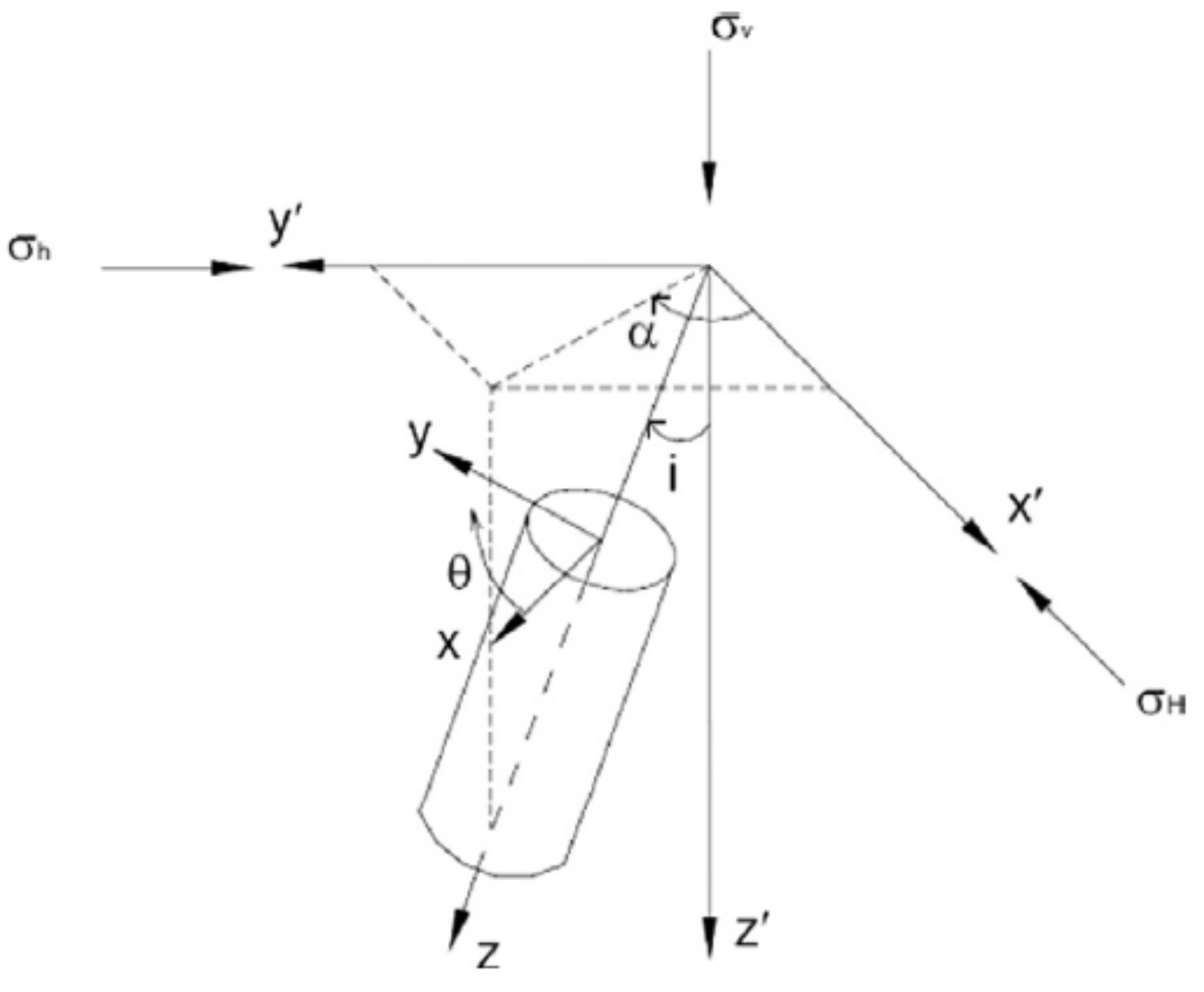Investigating Sand Production Phenomena: An Appraisal of Past and Emerging Laboratory Experiments and Analytical Models
Abstract
:1. Introduction
- To highlight the salient and, more importantly, the non-salient issues associated with the phenomenon
- To review the progress that has been made towards understanding the phenomenon
- To identify and examine state-of-the-art experimental and analytical techniques and tools used to investigate the process
- To track and assess past and current management and control strategies
- To reveal the constraints and limitations of techniques and tools used to investigate the process
- To proffer recommendations for better predictions, management and control strategies.
2. Sanding Mechanism and Failure Criteria
2.1. Stress Analysis
- Fully saturated reservoir formation
- Incompressibility of the reservoir and injected fluids
- Steady flow and pressure conditions
- Homogeneous and isotropic rock formation
- Axial symmetry of wellbore area
- Plane strain conditions
- Three-dimensional stress orientations with vertical and horizontal principal stresses
- Elastoplastic deformations.
2.2. Tensile Failure
2.3. Shear Failure
| = cohesive strength; | |
| = angle of internal friction; | |
| = major principal stress; | |
| = intermediate principal stress; | |
| = minor principal stress; | |
| = first invariant of the stress tensor; | |
| = second invariant of the deviatoric stress tensor; | |
| = material constant; | |
| = material constant; | |
| = constant that depend on the initial state of the rock material; | |
| = constant that depend on the initial state of the rock material; | |
| = uniaxial compressive strength; | |
| = octahedral shear stress; | |
| = effective normal stress. |
2.4. Compressive Failure (Pore Collapse)
3. Experimental Studies
4. Analytical Modelling
4.1. Stress at Wellbore Opening
| = Axial stress in (cylindrical coordinates); | |
| = Tangential stress (cylindrical coordinates); | |
| = Radial stress (cylindrical coordinates); | |
| , , | = Shear stresses at the wellbore face; |
| = In situ normal stresses in the x, y, z coordinate system; | |
| , , | = In situ shear stresses in the x, y, z coordinate system; |
| , , | = Vertical and horizontal in situ stresses; |
| = Poisson ratio; | |
| = Poroelastic stress coefficient; | |
| = Wellbore pressure; | |
| = Pore pressure at the wellbore; | |
| = Pore pressure at far field region; | |
| = Angle of rotation about the z axis referenced from the x axis; | |
| = Biot’s coefficient; | |
| = Angle of rotation about the z’ axis referenced from the x’ axis; | |
| = Angle of rotation about the y’ axis referenced from the z’ axis. |
4.2. Governing Equations
- The mass balance (continuity) equations for the different phases of the saturated porous material flow, comprising the solid, fluidised and liquid phases
- Equations for fluid through porous media
- Equations for permeability and porosity alteration
- Constitutive laws describing the poro-elastoplastic mechanical behaviour of the rock
- Constitutive laws describing the onset and/or rate of erosion of the solid mass
- Sanding criteria.
| = Total stresses; | |
| = Stress increments; | |
| = Tangent elasto-plastic stiffness matrix; | |
| = Strain increments; | |
| = Biot’s coefficient for effective stress; | |
| = Pore pressure; | |
| = Kronecker delta; | |
| = Tangent elasto-plastic porosity matrix; | |
| = Porosity. |
| = Rate of eroded mass generation; | |
| = Density of solid particles; | |
| = Density of mixture of fluid and solids; | |
| = Time; | |
| = transport concentration of fluidised solids; | |
| = Fluid flux; | |
| = Permeability parameter; | |
| = Sand production coefficient. |
4.3. Analytical Models
4.3.1. Shear Induced Sanding Prediction Models
| = Biot’s constant; | |
| = angle of internal friction; | |
| = bottom hole flow pressure (psi); | |
| = average reservoir pressure (psi); | |
| = cohesive strength (psi). |
| = radial co-ordinate (ft); | |
| = radius of cavity (wellbore, perforation tunnel) (ft); | |
| = pore fluid pressure (psi). |
| = material strength parameters; | |
| = isotropic loading hole failure stress; | |
| = equivalent stress at the cavity; | |
| = poroelastic constant; | |
| = lateral anisotropy (minor lateral stress/major lateral stress); | |
| = axial anisotropy (axial stress/major lateral stress); | |
| = ratio of pore pressure difference to lateral stress (pore pressure difference/major lateral stress); | |
| = first stress invariant of the stress tensor; | |
| = second stress invariant of the stress deviator tensor; | |
| = applied external axial stress; | |
| = applied external major lateral stress; | |
| = applied external minor lateral stress; | |
| = effective normal stress; | |
| = octahedral shear stress; | |
| = internal wellbore pressure; | |
| = pore pressure at wellbore wall; | |
| = pore pressure at far field; | |
| = poroelastic stress coefficient; | |
| = angle of failure. |
| = cumulative sand produced per unit length of the wellbore; | |
| = volumetric discharge rate of sand produced; | |
| = fluid + particle volumetric discharge per unit length of the wellbore; | |
| = porosity of yielded region; | |
| = porosity of intact region; | |
| = cohesion; | |
| = coefficient of friction; | |
| = parameter that is a function of the friction coefficient; | |
| = radial stress; | |
| = fluid pressure at yielded region; | |
| = permeability of yielded region; | |
| = fluid viscosity; | |
| = radius measured from the centre of the wellbore; | |
| = wellbore radius; | |
| = radius of yielded region; | |
| = coefficient that is related to porosity. |
| = total mass of sand produced; | |
| = loose sand due to emplacement of perforation tunnel; | |
| = mass of sand produced from the initially created plastic zone; | |
| = mass of sand produced from additional plastic zone; | |
| = perforation tunnel radius; | |
| = radius of plastic region; | |
| = radius of plastic region at the orifice (connecting the perforation and wellbore wall); | |
| = radius of plastic region at the fluid inlet (tip of perforation tunnel); | |
| = length of perforation; | |
| = number of perforations; | |
| = particle density; | |
| = rock porosity; | |
| = stages 1 and 2 respectively. |
| = maximum tangential stress; | |
| = minimum tangential stress; | |
| = maximum horizontal stress; | |
| = minimum horizontal stress; | |
| = wellbore pressure; | |
| = wellbore radius in the x direction; | |
| = wellbore radius in the y direction. |
| = well radius (m); | |
| = boundary radius (m); | |
| = sand production radius (m); | |
| = flowing bottom hole pressure (FBHP) (MPa); | |
| = reservoir pressure (MPa); | |
| = a coefficient; | |
| = thickness of reservoir segment considered (m); | |
| ; | |
| = expansion index; | |
| = maximum principal stress; | |
| = minimum principal stress. |
4.3.2. Tensile Failure-Based Sanding Prediction Models
| = radius of formation under consideration; | |
| = radius of perforation tunnel; | |
| = radius of perforation tip; | |
| = bottomhole flow pressure; | |
| = radial stress and minimum effective principal stress; | |
| = residual cohesion; | |
| = residual friction angle; | |
| = residual strength parameter; | |
| = residual strength parameter; | |
| = Critical bottomhole flow pressure for onset of sanding around perforation tunnel; | |
| = Critical bottomhole flow pressure for onset of sanding around perforation tip; | |
| = flow rate of gas; | |
| = gas formation volume factor; | |
| = length of perforation tunnel; | |
| = gas viscosity; | |
| = non-Darcy flow coefficient; | |
| = gas density; | |
| = permeability of plastic region. |
| = volume of sand eroded; | |
| = length of arch (cavity height); | |
| = radius of arch cavity; | |
| = radius of wellbore; | |
| = fluid flow rate; | |
| = gas condensate flow rate; | |
| = viscosity of fluid; | |
| = viscosity of gas condensate; | |
| = density of fluid; | |
| = density of gas; | |
| = density of oil; | |
| = acceleration due to gravity; | |
| = radius of sand particle; | |
| = fraction (in Moles) of condensate from gas; | |
| = amount of gas produced; | |
| = gas equivalence of the amount of condensate produced; |
| = mass of settled particles; | |
| = mass of flowing particles in the water mixture; | |
| = mass of flowing particles in the gas mixture; | |
| = heaviside step function; | |
| = parameter associated with the heaviside step function (water mixture); | |
| = parameter associated with the heaviside step function (gas mixture); | |
| = saturation with water; | |
| = saturation with gas; | |
| = time; | |
| = hydraulic gradient of water; | |
| = hydraulic gradient of gas; | |
| = critical hydraulic gradient of water below which there is no particle detachment; | |
| = critical hydraulic gradient of gas below which there is no particle detachment; | |
| = proportionality factor for change in state; | |
| = volume concentration of the flowing particles in the water mixture; | |
| = volume concentration of the flowing particles in the gas mixture; | |
| = particle density; | |
| = porosity; | |
| = volume of bulk soil (control volume); | |
| = volume of voids. |
4.3.3. Formulations Based on Mixture Theory
5. Summary and Further Discussion
Author Contributions
Funding
Institutional Review Board Statement
Informed Consent Statement
Data Availability Statement
Conflicts of Interest
References
- Litvinenko, V. The role of Hydrocarbons in the Global Energy Agenda: The Focus on Liquefied Natural Gas. Resources 2020, 9, 59. [Google Scholar] [CrossRef]
- US. Department of Energy, Energy Information Administration. Independent Statistics & Analysis. In Short-Term Energy Outlook; U.S. Department of Energy, Energy Information Administratio: Washington, DC, USA, 2021. Available online: https://www.eia.gov/outlooks/steo/report/global_oil.php (accessed on 17 June 2021).
- Yan, M.; Deng, J.; Yu, B.; Li, M.; Zhang, B.; Xiao, Q.; Tian, D. Comparative study on sanding characteristics between weakly consolidated sandstones and unconsolidated sandstones. J. Nat. Gas Sci. Eng. 2020, 76, 103183. [Google Scholar] [CrossRef]
- Isehunwa, S.; Farotade, A. Sand failure mechanism and sanding parameters in Niger Delta oil reservoirs. Int. J. Eng. Sci. Technol. 2010, 2, 777–782. [Google Scholar]
- Eshiet, K.I.-I. Modelling of Hydraulic Fracturing and Its Engineering Application. Ph.D. Thesis, University of Leeds, Leeds, UK, 2012. [Google Scholar]
- Nouri, A.; Vaziri, H.; Kuru, E.; Islam, R. A comparison of two sanding criteria in physical and numerical modeling of sand production. J. Pet. Sci. Eng. 2006a, 50, 55–70. [Google Scholar] [CrossRef]
- Servant, G.; Marchina, P.; Nauroy, J.-F. Near-wellbore: Sand production issues. In Proceedings of the the Annual Technical Conference and Exhibition, Anaheim, CA, USA, 11–14 November 2007. [Google Scholar]
- Eshiet, K.; Sheng, Y. Influence of rock failure behaviour on predictions in sand production problems. Environ. Earth Sci. 2013, 70, 1339–1365. [Google Scholar] [CrossRef]
- Papamichos, E.; Malmanger, E.M. A sand-erosion model for volumetric sand predictions in a North Sea reservoir. SPE Reserv. Eval. Eng. 2001, 4, 44–50. [Google Scholar] [CrossRef]
- Tronvoll, J.; Fjaer, E. Experimental study of sand production from perforation cavities. Int. J. Rock Mech. Min. Sci. Geomech. Abstr. 1994, 31, 393–410. [Google Scholar] [CrossRef]
- Mohamad-Hussein, A.; Mendoza, P.E.V.; Delbosco, P.F.; Sorgi, C.; De Gennaro, V.; Subbiah, S.K.; Ni, Q.; Serra, J.M.S.; Lakshmikantha, M.R.; Iglesias, J.A.; et al. Geomechanical modelling of cold heavy oil production with sand. Petroleum 2021, in press. [Google Scholar] [CrossRef]
- Al-Awad, M.N.J.; El-Sayed, H.; Desouky, S.E.M. Factors affecting sand production from unconsolidated sandstone Saudi oil and gas reservoir. J. King Saud Univ. Eng. Sci. 1999, 11, 151–174. [Google Scholar] [CrossRef]
- Li, Z.-d.; Pang, H.; Li, Z.; Zhang, H.-X.; Wang, D.-J.; Li, J. Sand production prediction model for tight sandstone oil reservoirs. Geofluids 2020, 2020, 8832703. [Google Scholar] [CrossRef]
- Shabdirova, A.; Minh, N.H.; Zhao, Y. A sand production prediction model for weak sandstone reservoir in Kazakhstan. J. Rock Mech. Geotech. Eng. 2019, 11, 760–769. [Google Scholar] [CrossRef]
- Wu, B.; Tan, C. Sand Production Prediction of gas field: Methodology and field application. In Proceedings of the SPE/ISRM Rock Mechanics Conference, Irving, TX, USA, 20–23 October 2002. [Google Scholar] [CrossRef]
- Eshiet, K.I.-I.; Yang, D.; Sheng, Y. Computational study of reservoir sand production mechanisms. Geotech. Res. 2019, 6, 177–204. [Google Scholar] [CrossRef] [Green Version]
- Nouri, A.; Vaziri, H.; Belhaj, H.; Islam, M.R. Comprehensive transient modeling of sand production in horizontal wellbores. SPE J. 2007, 14, 468–474. [Google Scholar] [CrossRef]
- Deng, J.; Wang, L.; Li, P.; Zhao, W. The critical pressure difference prediction of sand production in deep water sandstone gas reservoirs. Pet. Sci. Technol. 2013, 31, 1925–1932. [Google Scholar] [CrossRef]
- Wu, B.; Tan, C.P. Sand production prediction of gas field: Methodology and laboratory verification. In Proceedings of the Asia Pacific Oil and Gas Conference and Exhibition, Melbourne, Australia, 8–10 October 2002. [Google Scholar]
- Morita, N.; Boyd, P. Typical sand production problems: Case studies and strategies for sand control. In Proceedings of the SPE Annual Technical Conference and Exhibition, Dallas, TX, USA, 6–9 October 1991. [Google Scholar]
- Vardoulakis, I.; Stavropoulou, M.; Papanastasiou, R. Hydro-mechanical aspects of the sand production problem. Transp. Porous Media 1996, 22, 225–244. [Google Scholar] [CrossRef]
- Wang, H.; Towler, B.F.; Soliman, M.Y. Near-wellbore stress analysis and wellbore strengthening for drilling depleted formations. In Proceedings of the Rocky Mountain Oil & Gas Technology Symposium, Denver, CO, USA, 16–18 April 2007. [Google Scholar] [CrossRef]
- Garrouch, A.A.; Ebrahim, A.S. Analysis of the mechanical stability of boreholes drilled in sedimentary rocks. Pet. Sci. Technol. 2004, 22, 1535–1551. [Google Scholar] [CrossRef]
- Zoback, M.D.; Barton, C.A.; Brudy, M.; Castillo, D.A.; Finkbeiner, T.; Grollimund, B.R.; Moos, D.B.; Peska, P.; Ward, C.D.; Wiprut, D.J. Determination of stress orientation and magnitude in deep wells. Int. J. Rock Mech. Min. Sci. 2003, 40, 1049–1076. [Google Scholar] [CrossRef]
- Risnes, R.; Bratli, R.K.; Harsrud, P. Sand stresses around a wellbore. SPE J. 1982, 22, 883–898. [Google Scholar] [CrossRef]
- Elyasi, A.; Goshtasbi, K. Using different rock failure criteria in wellbore stability analysis. Geomech. Energy Environ. 2015, 2, 15–21. [Google Scholar] [CrossRef]
- Liao, S.-T.; Tsai, C.-L. Evolution of plastic zone around inclined wellbores using finite element simulation with generalised plane strain model. J. Jpn. Pet. Inst. 2009, 52, 231–238. [Google Scholar] [CrossRef] [Green Version]
- Yi, X.; Valko, P.P.; Russell, J.E. Effect of rock strength criterion on the predicted onset of sand production. Int. J. Geomech. 2005, 5, 66–73. [Google Scholar] [CrossRef] [Green Version]
- Chen, W.; Mizuno, E. Nonlinear Analysis in Soil Mechanics—Theory and Implementation; Elsevier: New York, NY, USA, 1990. [Google Scholar]
- Drucker, D.; Prager, W. Soil mechanics and plastic analysis or limit design. Q. Appl. Math. 1952, 10, 57–165. [Google Scholar] [CrossRef] [Green Version]
- Ewy, R.T. Wellbore-stability predictions by use of a modified lade criterion. SPE Drill. Completion 1999, 6, 85–91. [Google Scholar] [CrossRef]
- Lade, P.V. Elasto-plastic stress–strain theory for cohesionless soil with curved yield surfaces. Int. J. Solids Struct. 1977, 13, 1014–1035. [Google Scholar] [CrossRef]
- Hoek, E.; Brown, E. Underground Excavations in Rock; The Institution of Mining and Metallurgy: London, UK, 1980. [Google Scholar]
- Wang, Y.; Wu, B. Borehole collapse and sand production evaluation: Experimental testing, analytical solutions and field applications. In Proceedings of the DC Rocks 2001, The 38th U.S. Symposium on Rock Mechanics (USRMS), Washington, DC, USA, 7–10 July 2001; pp. 67–74. [Google Scholar]
- Al-Shaaibi, S.K.; Al-Ajmi, A.M.; Al-Wahaibi, Y. Three-dimensional modeling for predicting sand production. J. Pet. Sci. Eng. 2013, 109, 348–363. [Google Scholar] [CrossRef]
- Al-Ajmi, A.M.; Zimmerman, R.W. Relationship between the parameters of the Mogi and Coulomb failure criterion. Int. J. Rock Mech. Min. Sci. 2005, 42, 431–439. [Google Scholar] [CrossRef]
- Awal, M.R.; Azeemuddin, M.; Khan, M.S.; Abdulraheem, A.; Mohiuddin, M.A. A more realistic sand production prediction using pore collapse theory. In Proceedings of the 38th U.S. Symposium on Rock Mechanics (USRMS), Washington, DC, USA, 7 July 2001. [Google Scholar]
- Abdulraheem, A.; Roegiers, J.-C.; Zaman, M. Mechanics of pore collapse and compaction in weak porous rocks. In Proceedings of the 33rd U.S. Symposium on Rock Mechanics (USRMS), Santa Fe, New Mexico, 3 June 1992. [Google Scholar]
- Gahramanov, G.N.O. Formation of Oil and Gas Reservoirs in the Great Depths of the South Caspian Depression. Earth Sci. Res. J. 2017, 21, 169–174. [Google Scholar] [CrossRef] [Green Version]
- Ehrenberg, S.N.; Nadeau, P.H.; Steen, Ø. Petroleum reservoir porosity versus depth: Influence of geological age. AAPG Bull. 2009, 93, 1281–1296. [Google Scholar] [CrossRef]
- Younessi, A.; Rasouli, V.; Wu, B. Proposing a Sample Preparation Procedure for Sanding Experiments. In Proceedings of the Southern Hemisphere International Rock Mechanics Symposium SHIRMS 2012, Sun City, South Africa, 14–17 May 2012. [Google Scholar]
- Fattahpour, V.; Moosavi, M.; Mehranpour, M. An experimental investigation on the effect of grain size on oil-well sand production. Petrol. Sci. 2012, 9, 343–353. [Google Scholar] [CrossRef] [Green Version]
- Fattahpour, V.; Moosavi, M.; Mehranpour, M. An experimental investigation on the effect of rock strength and perforation size on sand production. J. Petrol. Sci. Eng. 2012, 86, 172–189. [Google Scholar] [CrossRef]
- Nouri, A.; Vaziri, H.H.; Belhaj, H.A.; Islam, M.R. Sand production prediction: A new set of criteria for modeling based on large-scale transient experiments and numerical investigation. SPE J. 2006, 11, 227–237. [Google Scholar] [CrossRef]
- Younessi, A.; Rasouli, V.; Wu, B. Sand production simulation under true-triaxial stress conditions. Int. J. Rock Mech. Min. Sci. 2013, 61, 130–140. [Google Scholar] [CrossRef] [Green Version]
- Eshiet, K.I.-I.; Sheng, Y. Overview of Principles and Designs of Hydraulic Fracturing Experiments and an Inquiry into the Influence of Rock Permeability and Strength on Failure Mode. In Advances in Natural Gas Emerging Technologies; Al-Megren, H.A., Altamimi, R.H., Eds.; IntechOpen: London, UK, 2017. [Google Scholar]
- Papamichos, E. Analytical models for onset of sand production under isotropic and anisotropic stresses in laboratory tests. Geomech. Energy Environ. 2020, 21, 100149. [Google Scholar] [CrossRef]
- Deng, F.; Yan, C.; Jia, S.; Chen, S.; Wang, L.; He, L. Influence of Sand Production in an Unconsolidated Sandstone Reservoir in a Deepwater Gas Field. J. Energy Resour. Technol. 2019, 141, 092904. [Google Scholar] [CrossRef]
- Hoang, S.K.; Trinh, V.X.; Tran, T.V.; Dang, T.A. Comprehensive sanding study from laboratory experiments, modeling, field implementation, to real-time monitoring, a case study for Hai Thach and Moc Tinh fields, offshore Vietnam. In Proceedings of the SPE/IATMI Asia Pacific Oil & Gas Conference and Exhibition, Jakarta, Indonesia, 17–19 October 2017. [Google Scholar]
- Khamehchi, E.; Reisi, E. Sand production prediction using ratio of shear modulus to bulk compressibility (case study). Egypt. J. Pet. 2015, 24, 113–118. [Google Scholar] [CrossRef] [Green Version]
- Papamichos, E.; Vardoulakis, I.; Tronvoll, J.; Skjaerstein, A. Volumetric sand production model and experiment. Int. J. Rock Mech. Min. Sci. 2001, 25, 789–808. [Google Scholar] [CrossRef]
- Willson, S.M.; Moschovidis, Z.A.; Cameron, J.R.; Palmer, I.D. New Model for Predicting the Rate of Sand Production. In Proceedings of the SPE/ISRM Rock Mechanics Conference, Irving, TX, USA, 20–23 October 2002. [Google Scholar] [CrossRef]
- Chin, L.Y.; Ramos, G.G. Predicting Volumetric Sands Production in Weak Reservoirs. In Proceedings of the SPE/ISRM Rock Mechanics Conference, Irving, TX, USA, 20–23 October 2002. [Google Scholar]
- Cook, J.M.; Bradford, I.D.R.; Plumb, R.A. A Study of the Physical Mechanisms of Sanding and Application to Sand Production Prediction. In Proceedings of the European Petroleum Conference, London, UK, 25–27 October 1994. [Google Scholar] [CrossRef]
- Perera MS, A.; Ranjith, P.G.; Rathnaweera, T.D.; De Silva GP, D.; Liu, T. An experimental study to quantify sand production during oil recovery from unconsolidated quicksand formations. Petrol. Explor. Develop. 2017, 44, 860–865. [Google Scholar] [CrossRef]
- Tremblay, B.; Sedgwick, G.; Vu, D. CT imaging of wormhole growth under solution-gas drive. SPE Reserv. Eval. Eng. 1999, 2, 37–45. [Google Scholar] [CrossRef]
- Smith, I. Elements of Soil Mechanics, 10th ed.; Wiley Blackwell: Hoboken, NJ, USA, 2021. [Google Scholar]
- Whitlow, R. Basic Soil Mechanics, 4th ed.; Pearson: London, UK, 2000. [Google Scholar]
- Tronvoll, J.; Sønstebø, E.F. Productivity effects of drawdown and depletion in open hole completions: Do screens plug? In Proceedings of the 1997 SPE European Formation Damage Conference, The Hague, The Netherlands, 2–3 June 1997.
- Tronvoll, J.; Skjaerstein, A.; Papamichos, E. Sand production: Mechanical failure or hydrodynamic erosion? Int. J. Rock Mech. Min. Sci. 1997, 34, 3–4. [Google Scholar] [CrossRef]
- Papamichos, E.; Cerasi, P.; Stenebraten, J.F.; Berntsen, A.N.; Ojala, I.; Vardoulakis, I.; Brignoli, M.; Fuh, G.-F.; Han, G.; Nadeem, A.; et al. Sand production rate under multiphase flow and water breakthrough. In Proceedings of the 44th US Rock Mechanics Symposium and 5th U.S.-Canada Rock Mechanics Symposium, Salt Lake City, UT, USA, 27–30 June 2010. [Google Scholar]
- Vaziri, H.H.; Lemoine, E.; Palmer, I.D.; McLennan, J.; Islam, R. How Can Sand Production Yield a Several-Fold Increase in Productivity: Experimental and Field Data? In Proceedings of the 2000 SPE Annual Technical Conference and Exhibition, 1–4 October 2000; Dallas, TX, USA. [Google Scholar]
- Servant, G.; Marchina, P.; Peysson, E.; Bemer, E.; Nauroy, J. Sand erosion in weakly consolidated reservoirs: Experiments and numerical modeling. In Proceedings of the SPE/DOE Symposium on Improved Oil Recovery, Tulsa, OK, USA, 22–26 April 2006. [Google Scholar]
- Schofield, A.N. Cambridge Geotechnical Centrifuge Operations. Géotechnique 1980, 30, 227–268. [Google Scholar] [CrossRef] [Green Version]
- Younessi, A.; Rasouli, V.; Wu, B. Experimental sanding analysis: Thick-walled cylinder versus true triaxial tests. In The Southern African Institute of Mining and Metallurgy. In Proceedings of the Southern Hemisphere International Rock Mechanics Symposium SHIRMS 2012, Sun City, South Africa, 14–17 May 2012. [Google Scholar]
- Rahmati, H.; Nouri, A.; Vaziri, H.; Chan, D. Validation of predicted cumulative sand and sand rate against physical-model test. J. Can. Pet Technol. 2012, 51, 403–410. [Google Scholar] [CrossRef]
- Fjær, E.; Holt, R.M.; Horsrud, P.; Raaen, A.M.; Risnes, R. Petroleum Related Rock Mechanics, 2nd ed.; Elsevier: Amsterdam, The Netherlands, 2008; p. 491. [Google Scholar]
- Al-Ajmi, A. Wellbore Stability Analysis Based on a New True-Triaxial Failure Criterion. Ph.D. Thesis, KTH Royal Institute of Technology, Stockholm, Sweden, 2006. [Google Scholar]
- Al-Ajmi, A.M.; Zimmerman, R.W. A New 3D Stability Model for the Design of Non-Vertical Wellbores. In Proceedings of the 41st U.S. Symposium on Rock Mechanics (USRMS): “50 Years of Rock Mechanics—Landmarks and Future Challenges”, Golden Rocks, Colorado, 17–21 June 2006. [Google Scholar]
- Papamichos, E.; Vardoulakis, I. Sand erosion with a porosity diffusion law. Comput. Geotech. 2005, 32, 47–58. [Google Scholar] [CrossRef]
- Papamichos, E.; Stavropoulou, M. An erosion-mechanical model for sand production rate prediction. Int. J. Rock Mech. Min. Sci. 1998, 35, 531–532. [Google Scholar] [CrossRef]
- Stavropoulou, M.; Papanastasiou, P.; Vardoulakis, I. Coupled wellbore erosion and stability analysis. Int. J. Num. Anal. Methods Geomech. 1998, 22, 749–769. [Google Scholar] [CrossRef]
- Yi, X. Numerical and Analytical Modeling of Sanding Onset Prediction. Ph.D. Thesis, Texas A & M University, College Station, TX, USA, 2003. [Google Scholar]
- Gholami, R.; Aadnoy, B.; Rasouli, V.; Fakhari, N. An analytical model to predict the volume of sand during drilling and production. J. Rock Mech. Geotech. Eng. 2016, 8, 521–532. [Google Scholar] [CrossRef] [Green Version]
- Hayavi, M.T.; Abdideh, M. Establishment of tensile failure induced sanding onset prediction model for cased-perforated gas wells. J. Rock Mech. Geotech. Eng. 2017, 9, 260–266. [Google Scholar] [CrossRef]
- Jianguang, W.; Chuanliang, Y. Sand production prediction in pressure depleted reservoirs. Sci. Bull. NMU 2015, 1, 49–53. [Google Scholar]
- Papamichos, E.; Furuic, K. Analytical models for sand onset under field conditions. J. Pet. Sci. Eng. 2019, 172, 171–189. [Google Scholar] [CrossRef]
- Weingarten, J.S.; Perkins, T.K. Prediction of Sand Production in Gas Wells: Methods and Gulf of Mexico Case Studies. J. Pet. Technol. 1995, 47, 596–600. [Google Scholar] [CrossRef]
- Uchida, S.; Assaf, K.; Yamamoto, K. Sand production modeling as hydrate-bearing sediments. Int. J. Rock Mech. Min. Sci. 2016, 86, 303–316. [Google Scholar] [CrossRef]
- Isehunwa, S.O.; Olanrewaju, O. A Simple Analytical Model for Predicting Sand Production in a Niger Delta Oil Field. Int. J. Eng. Sci. Technol. 2010, 2, 4379–4387. [Google Scholar]
- Isehunwa, S.O.; Ogunkunle, T.F.; Onwuegbu, S.M.; Akinsete, O.O. Prediction of sand production in gas and gas condensate wells. J. Pet. Gas Eng. 2017, 8, 29–35. [Google Scholar] [CrossRef]
- Geilikman, M.B.; Dusseault, M.B. Fluid rate enhancement from massive sand production in heavy-oil reservoirs. J. Pet. Sci. Eng. 1997, 17, 5–18. [Google Scholar] [CrossRef]
- Bratli, R.K.; Risnes, R. Stability and failure of sand arches. SPE J. 1981, 21, 236–248. [Google Scholar] [CrossRef]
- Goshtasbi, K.; Elyasi, A.; Naeimipour, A. Numerical assessment of the mechanical stability in vertical, directional and horizontal wellbores. Int. J. Min. Sci. Technol. 2013, 23, 937–942. [Google Scholar] [CrossRef]
- Lekhnitskii, S.G. Anisotropic Plates; Gordon and Breach: New York, NY, USA, 1968. [Google Scholar]
- Nouri, A.; Al-Darbi, M.M.; Vaziri, H.; Islam, M.R. Deflection criteria for numerical assessment of the sand production potential in an openhole completion. Energy Sources 2002, 24, 685–702. [Google Scholar] [CrossRef]
- Ong, S.; Ramos, R.; Zheng, Z. Sand production prediction in high rate, perforated and open-hole gas wells. In Proceedings of the SPE International Symposium on Formation Damage Control, Lafayette, Louisiana, 23–24 February 2000. [Google Scholar] [CrossRef]
- Yi, X.; Valko, P.P.; Russell, J.E. Predicting critical drawdown for the onset of sand production. In Proceedings of the SPE International Symposium and Exhibition on Formation Damage Control, Lafayette, LA, USA, 18–20 February 2004. [Google Scholar] [CrossRef]
- Forchheimer, P.H. Wasserbewegun durch boden [Movement of Water through Soil]. Z. Des Ver. Dtsch. Ing. 1901, 45, 1782–1788. (In German) [Google Scholar]
- Klar, A.; Uchida, S.; Soga, K.; Yamamoto, K. Explicitly Coupled Thermal Flow Mechanical Formulation for Gas-Hydrate Sediments. SPE J. 2013, 18, 196–206. [Google Scholar] [CrossRef]
- Detournay, C. Numerical Modeling of the Slit Mode of Cavity Evolution Associated with Sand Production. SPE J. 2009, 14, 797–804. [Google Scholar] [CrossRef]
- Yi, X. Water Injectivity Decline Caused by Sand Mobilization: Simulation and Prediction. In Proceedings of the SPE Permian Basin Oil and Gas Recovery Conference, Midland, TX, USA, 15–17 May 2001. [Google Scholar] [CrossRef]
- Papamichos, E.; Malmanger, E.M. A Sand Erosion Model for Volumetric Sand Predictions in a North Sea Reservoir. In Proceedings of the Latin American and Caribbean Petroleum Engineering Conference, Caracas, Venezuela, 21–23 April 1999. [Google Scholar] [CrossRef]
- Skjaerstein, A.; Tronvoll, J.; Santarelli, F.J.; Joranson, H. Effect of Water Breakthrough on Sand Production: Experimental and Field Evidence. In Proceedings of the SPE Annual Technical Conference and Exhibition, San Antonio, TX, USA, 5–8 October 1997. [Google Scholar] [CrossRef]
- Kozeny, J. Ueber kapillare Leitung des Wassers im Boden. R. Acad. Sci. Vienna Proc. Cl. I 1927, 136, 271–306. [Google Scholar]
- Carman, P.C. Fluid flow through granular beds. Trans. Inst. Chem. Eng. 1937, 15, 150–166. [Google Scholar] [CrossRef]
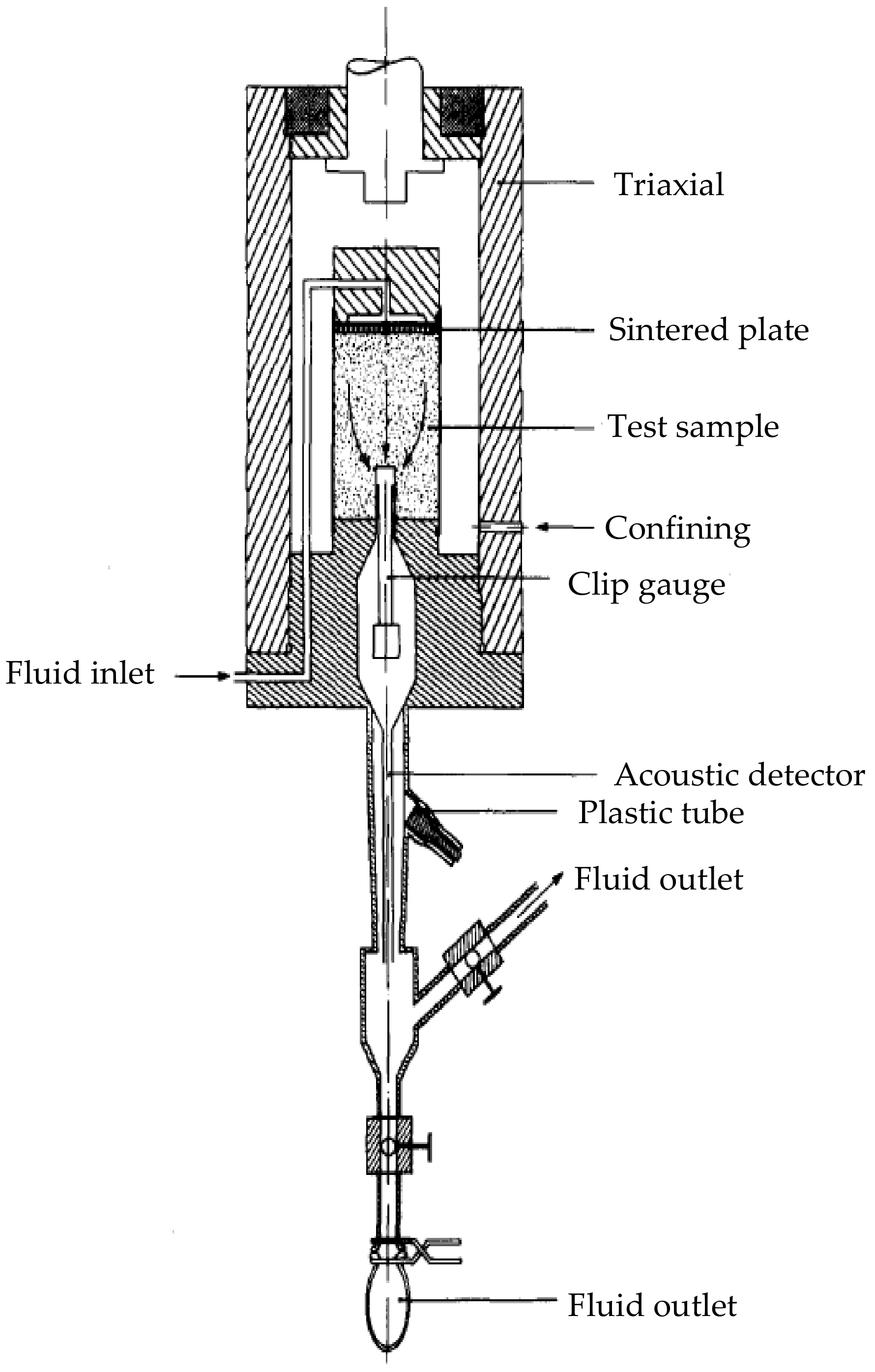
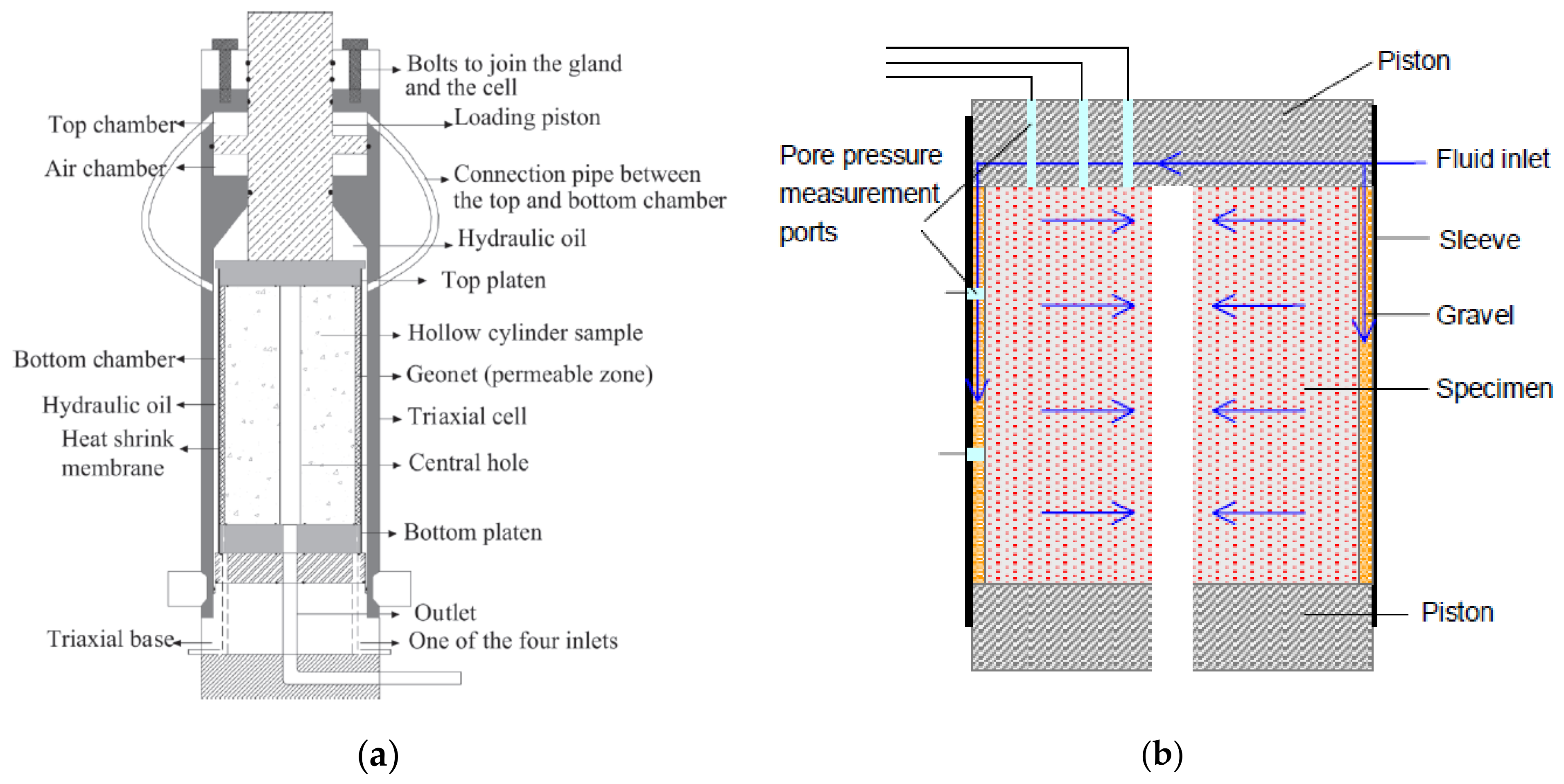
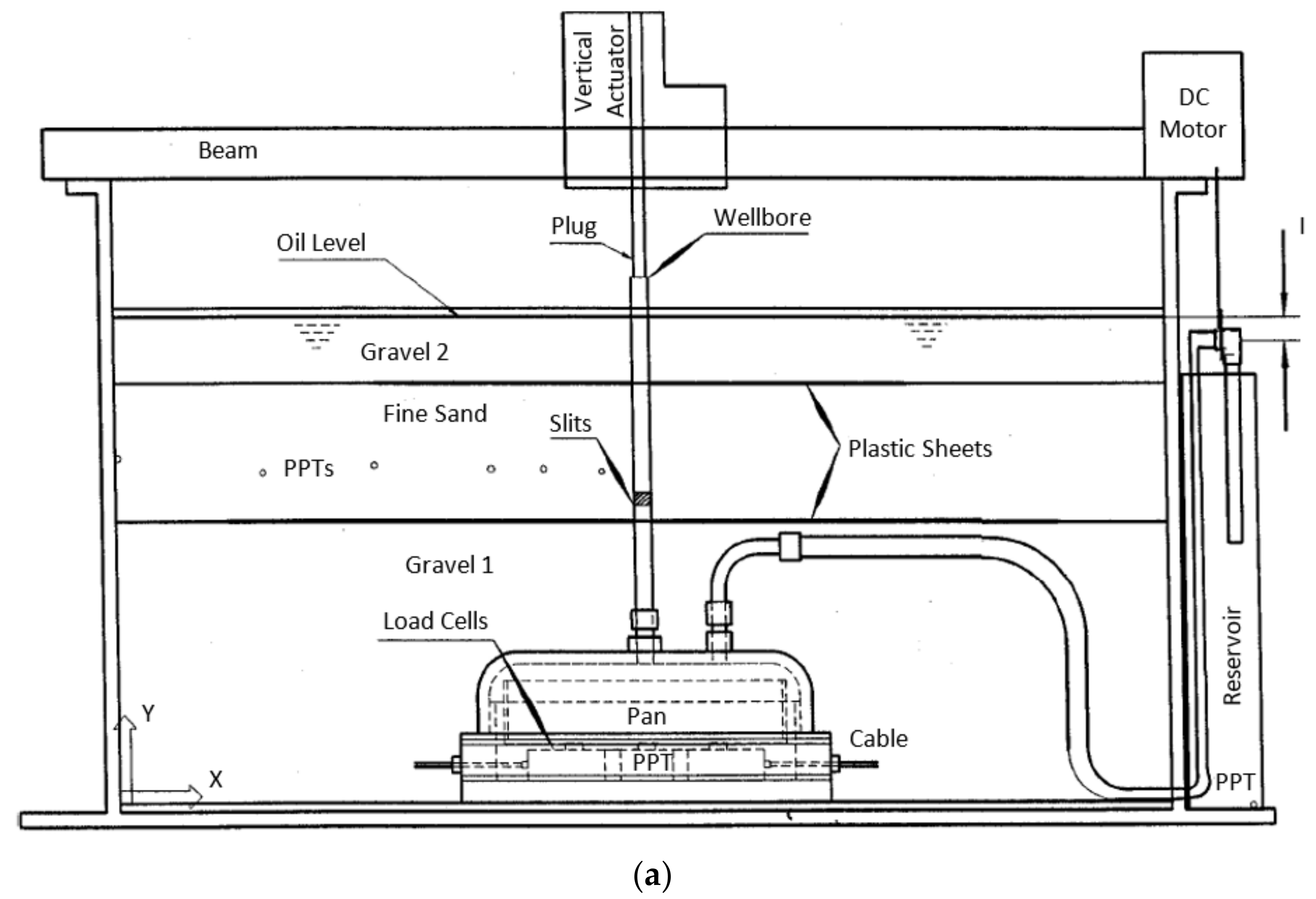

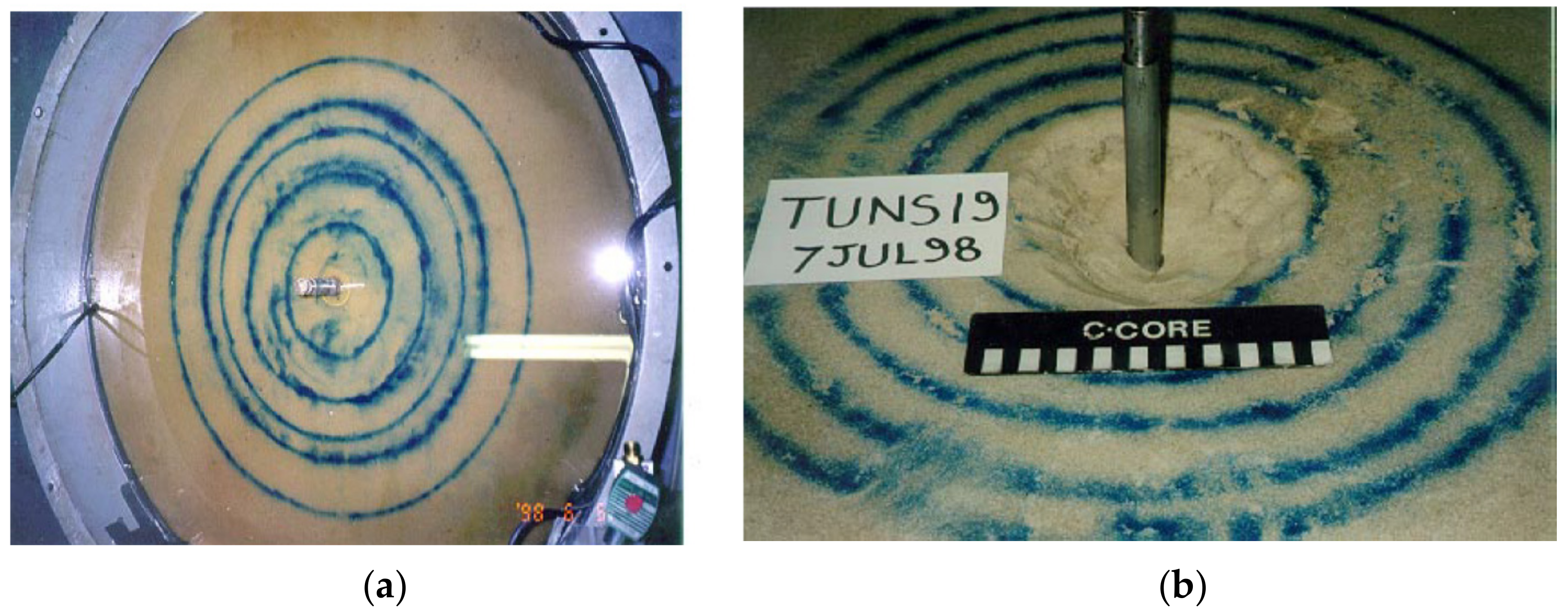
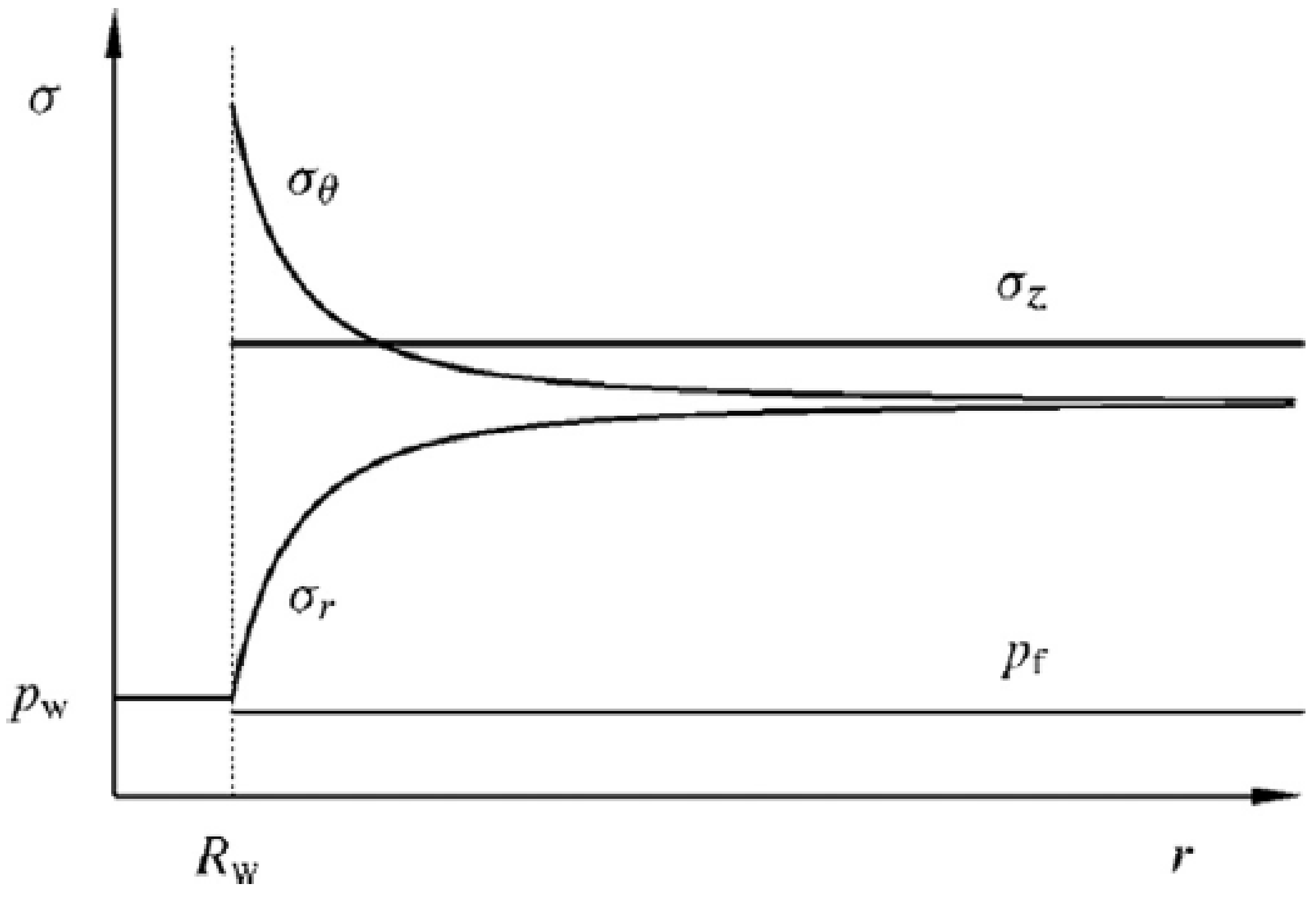
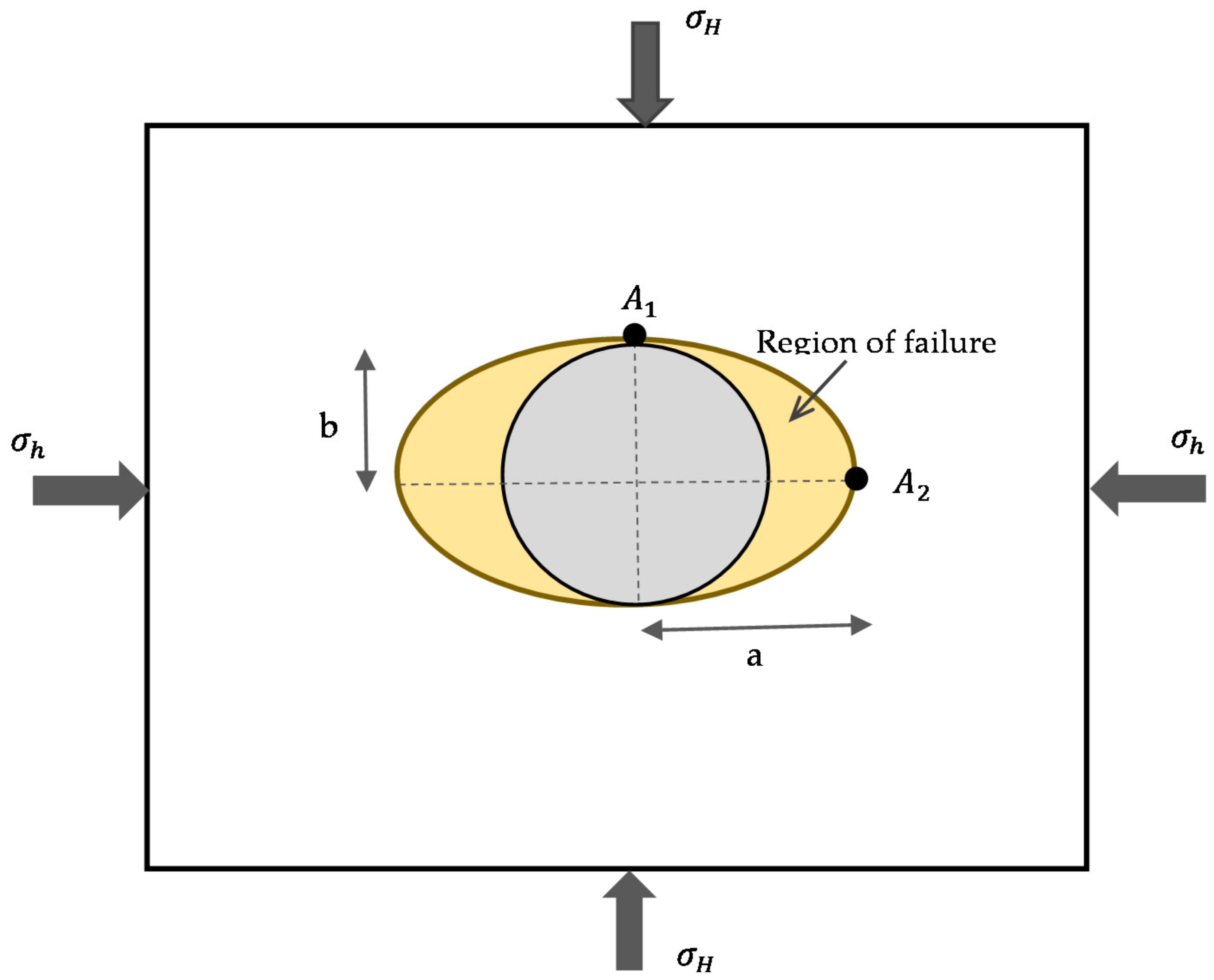
| Failure Criterion (F ≤ 0) | Function (F) | Definition of Parameters | |
|---|---|---|---|
| Mohr–Coulomb [28,29] | (1) | ||
| Drucker–Prager [28,30] | = | (2) | |
| or | |||
| or | |||
| Modified-Lade [28,31,32] | (3) | ||
| Hoek–Brown [28,33,34] | + | (4) | |
| Mogi–Coulomb [35,36] | (5) | ||
| Type of Specimen | Authors | External Diameter or (Length × Breadth) (mm) | Internal through Hole Diameter (mm) | Height (mm) | Non-Through or Blind Hole (Perforation Tunnel) Diameter (mm) | Blind Hole (Perforation Tunnel) Depth (mm) |
|---|---|---|---|---|---|---|
| Hollow cylinder | Papamichos et al. [61]; Papamichos et al. [51]; | 200 | 20 | 200 | * N/A | N/A |
| Nouri et al. [44] | 125 | 25.4 | - | N/A | N/A | |
| Hollow cube | Younessi et al. [45]; Younessi et al. [41]; Younessi et al. [65] | 100 × 100 | 15 | 100 | N/A | N/A |
| Perforation (blind hole) cylinder | Yan et al. [3] | 100 | N/A | 100 | 16 | 60 |
| Tronvoll et al. [60]; Tronvoll and Fjaer [10] | 100 | N/A | 150 | 20 | 60 | |
| Rahmati et al. [66] | 152.4 | N/A | 254 | 12.7 | 50.8 | |
| Fattahpour et al. [43] | 150 | N/A | 300 | 10–20 | 150 | |
| Sand bed (oedometer cell with through inner tube) | Servant et al. [63] | 300 | - | 65 | N/A | N/A |
| Sand bed (box in centrifuge with through inner tube) | Vaziri et al. [62] | 900 | 20 | 100 | N/A | N/A |
| Failure Criterion | Sanding Onset Criterion | Parameter Definition/Comments | |
|---|---|---|---|
| Von Mises(VM): | (48) | ||
| Drucker Prager: It is expressed in terms of the axial and tangential cavity stresses as | (49) | ||
| Mohr–Coulomb: . This criterion is reduced to It is expressed in terms of the axial and tangential cavity stresses as | (under isotropic loading and no flow) | (50) | |
| Simplified Mohr–Coulomb: It assumes that the axial and shear stress do not contribute to the failure. | (under isotropic loading and no flow) | (51) |
| Failure Criterion | Sanding Onset Criterion | Parameter Definition/Comments | |
|---|---|---|---|
| Mogi–Coulomb: | (52) | ||
| Mohr–Coulomb: | (53) |
| Author(s) | Erosion Criterion Parameters | Erosion Formulation | |
|---|---|---|---|
| Vardoulakis et al. [21] | The rate of mass generation () is proportional to and becomes operational once is non-zero. | (78) | |
| Papamichos and Stavropoulou [71] | (79) | ||
| Stavropoulou et al. [72] | Not explicitly defined, but is a function of rock damage. is the critical value that reveals when the rate of particle deposition and erosion are equal. | (80) | |
| Yi [91] | Not explicitly defined, but are functions of rock damage. | (81) | |
| Papamichos et al. [51] | (82) | ||
| Chin and Ramos [53] | Not explicitly defined | (83) | |
| Detournay [91] | Erosion criterion is a function of the critical flow rate, . Sanding occurs when the flow rate is above the critical value. | (84) |
Publisher’s Note: MDPI stays neutral with regard to jurisdictional claims in published maps and institutional affiliations. |
© 2021 by the authors. Licensee MDPI, Basel, Switzerland. This article is an open access article distributed under the terms and conditions of the Creative Commons Attribution (CC BY) license (https://creativecommons.org/licenses/by/4.0/).
Share and Cite
Eshiet, K.I.-I.I.; Sheng, Y. Investigating Sand Production Phenomena: An Appraisal of Past and Emerging Laboratory Experiments and Analytical Models. Geotechnics 2021, 1, 492-533. https://doi.org/10.3390/geotechnics1020023
Eshiet KI-II, Sheng Y. Investigating Sand Production Phenomena: An Appraisal of Past and Emerging Laboratory Experiments and Analytical Models. Geotechnics. 2021; 1(2):492-533. https://doi.org/10.3390/geotechnics1020023
Chicago/Turabian StyleEshiet, Kenneth Imo-Imo Israel, and Yong Sheng. 2021. "Investigating Sand Production Phenomena: An Appraisal of Past and Emerging Laboratory Experiments and Analytical Models" Geotechnics 1, no. 2: 492-533. https://doi.org/10.3390/geotechnics1020023
APA StyleEshiet, K. I.-I. I., & Sheng, Y. (2021). Investigating Sand Production Phenomena: An Appraisal of Past and Emerging Laboratory Experiments and Analytical Models. Geotechnics, 1(2), 492-533. https://doi.org/10.3390/geotechnics1020023






